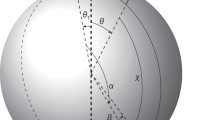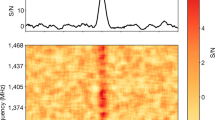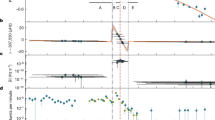Abstract
Anomalous X-ray pulsars (AXPs) are slowly rotating neutron stars with very bright and highly variable X-ray emission that are believed to be powered by ultra-strong magnetic fields of >1014 G, according to the ‘magnetar’ model1. The radio pulsations that have been observed from more than 1,700 neutron stars with weaker magnetic fields have never been detected from any of the dozen known magnetars. The X-ray pulsar XTE J1810 - 197 was revealed (in 2003) as the first AXP with transient emission when its luminosity increased 100-fold from the quiescent level2; a coincident radio source of unknown origin was detected one year later3. Here we show that XTE J1810 - 197 emits bright, narrow, highly linearly polarized radio pulses, observed at every rotation, thereby establishing that magnetars can be radio pulsars. There is no evidence of radio emission before the 2003 X-ray outburst (unlike ordinary pulsars, which emit radio pulses all the time), and the flux varies from day to day. The flux at all radio frequencies is approximately equal—and at >20 GHz XTE J1810 - 197 is currently the brightest neutron star known. These observations link magnetars to ordinary radio pulsars, rule out alternative accretion models for AXPs, and provide a new window into the coronae of magnetars.
This is a preview of subscription content, access via your institution
Access options
Subscribe to this journal
Receive 51 print issues and online access
$199.00 per year
only $3.90 per issue
Buy this article
- Purchase on Springer Link
- Instant access to full article PDF
Prices may be subject to local taxes which are calculated during checkout


Similar content being viewed by others
References
Duncan, R. C. & Thompson, C. Formation of very strongly magnetized neutron stars: implications for gamma-ray bursts. Astrophys. J. 392, L9–L13 (1992)
Ibrahim, A. I. et al. Discovery of a transient magnetar: XTE J1810 - 197. Astrophys. J. 609, L21–L24 (2004)
Halpern, J. P., Gotthelf, E. V., Becker, R. H., Helfand, D. J. & White, R. L. Discovery of radio emission from the transient anomalous X-ray pulsar XTE J1810 - 197. Astrophys. J. 632, L29–L32 (2005)
Israel, G. L. et al. Accurate X-ray position of the anomalous X-ray pulsar XTE J1810 - 197 and identification of its likely infrared counterpart. Astrophys. J. 603, L97–L100 (2004)
Manchester, R. N. et al. The Parkes multi-beam pulsar survey—I. Observing and data analysis systems, discovery and timing of 100 pulsars. Mon. Not. R. Astron. Soc. 328, 17–35 (2001)
Cordes, J. M., Bhat, N. D. R., Hankins, T. H., McLaughlin, M. A. & Kern, J. The brightest pulses in the Universe: multifrequency observations of the Crab pulsar's giant pulses. Astrophys. J. 612, 375–388 (2004)
Cordes, J. M. & Lazio, T. J. W. NE2001. I. A new model for the Galactic distribution of free electrons and its fluctuations. Preprint at http://arxiv.org/astro-ph/0207156 (2002).
Gotthelf, E. V. & Halpern, J. P. The spectral evolution of transient anomalous X-ray pulsar XTE J1810 - 197. Astrophys. J. 632, 1075–1085 (2005)
Gotthelf, E. V., Halpern, J. P., Buxton, M. & Bailyn, C. Imaging X-ray, optical, and infrared observations of the transient anomalous X-ray pulsar XTE J1810 - 197. Astrophys. J. 605, 368–377 (2004)
Durant, M. & van Kerkwijk, M. H. Distances to anomalous X-ray pulsars using red clump stars. Astrophys. J. (in the press); preprint at http://arxiv.org/astro-ph/0606027 (2006).
Rickett, B. J. Radio propagation through the turbulent interstellar plasma. Annu. Rev. Astron. Astrophys. 28, 561–605 (1990)
Narayan, R. The physics of pulsar scintillation. Phil. Trans. R. Soc. A 341, 151–165 (1992)
Lorimer, D. R., Yates, J. A., Lyne, A. G. & Gould, D. M. Multifrequency flux density measurements of 280 pulsars. Mon. Not. R. Astron. Soc. 273, 411–421 (1995)
Kaspi, V. M. & McLaughlin, M. A. Chandra X-ray detection of the high-magnetic-field radio pulsar PSR J1718–3718. Astrophys. J. 618, L41–L44 (2005)
McLaughlin, M. A. et al. Transient radio bursts from rotating neutron stars. Nature 439, 817–820 (2006)
Reynolds, S. P. et al. Discovery of the X-ray counterpart to the rotating radio transient J1819–1458. Astrophys. J. 639, L71–L74 (2006)
Thompson, C. & Beloborodov, A. M. High-energy emission from magnetars. Astrophys. J. 634, 565–569 (2005)
Beloborodov, A. M. & Thompson, C. Corona of magnetars. Astrophys. J. (submitted); preprint at http://arxiv.org/astro-ph/0602417 (2006).
Zhang, B. On the radio quiescence of anomalous X-ray pulsars and soft gamma-ray repeaters. Astrophys. J. 562, L59–L62 (2001)
Thompson, C., Lyutikov, M. & Kulkarni, S. R. Electrodynamics of magnetars: implications for the persistent X-ray emission and spin-down of the soft gamma repeaters and anomalous X-ray pulsars. Astrophys. J. 574, 332–355 (2002)
Goldreich, P. & Julian, W. H. Pulsar electrodynamics. Astrophys. J. 157, 869–880 (1969)
Eichler, D., Gedalin, M. & Lyubarsky, Y. Coherent emission from magnetars. Astrophys. J. 578, L121–L124 (2002)
Eichler, D., Lyubarsky, Y., Thompson, C. & Woods, P. M. In Pulsars, AXPs and SGRs Observed with BeppoSAX and Other Observatories (eds Cusumano, G., Massaro, E. & Mineo, T.) 215–222 (Aracne Editrice, Rome, 2003)
Lyutikov, M. Radio emission from magnetars. Astrophys. J. 580, L65–L68 (2002)
Rea, N. et al. Correlated infrared and X-ray variability of the transient anomalous X-ray pulsar XTE J1810 - 197. Astron. Astrophys. 425, L5–L8 (2004)
Halpern, J. P. & Gotthelf, E. V. The fading of transient anomalous X-ray pulsar XTE J1810 - 197. Astrophys. J. 618, 874–882 (2005)
Backer, D. C. Peculiar pulse burst in PSR 1237 + 25. Nature 228, 1297–1298 (1970)
Backer, D. C. et al. A digital signal processor for pulsar research. Publ. Astron. Soc. Pacif. 109, 61–68 (1997)
Kaplan, D. L. et al. The Green Bank Telescope pulsar Spigot. Publ. Astron. Soc. Pacif. 117, 643–653 (2005)
Drake, F. D. & Craft, H. D. Second periodic pulsations in pulsars. Nature 220, 231–235 (1968)
Acknowledgements
We thank J. Cohen and B. Mason for giving us some of their observing time, M. Kramer and M. McLaughlin for providing us with Parkes multibeam survey archival data, and D. Backer, D. Kaplan, and B. Jacoby for their contributions to developing pulsar observing equipment at GBT. The Parkes Observatory is part of the Australia Telescope, which is funded by the Commonwealth of Australia for operation as a National Facility managed by CSIRO. The National Radio Astronomy Observatory is a facility of the US National Science Foundation (NSF), operated under cooperative agreement by Associated Universities, Inc. F.C. acknowledges support from NSF and NASA.
Author information
Authors and Affiliations
Corresponding author
Ethics declarations
Competing interests
Reprints and permissions information is available at www.nature.com/reprints. The authors declare no competing financial interests.
Rights and permissions
About this article
Cite this article
Camilo, F., Ransom, S., Halpern, J. et al. Transient pulsed radio emission from a magnetar. Nature 442, 892–895 (2006). https://doi.org/10.1038/nature04986
Received:
Accepted:
Issue Date:
DOI: https://doi.org/10.1038/nature04986
This article is cited by
-
Slow-beating radio waves from a long-lived source
Nature (2023)
-
Quasi-periodic sub-pulse structure as a unifying feature for radio-emitting neutron stars
Nature Astronomy (2023)
-
Discovery of a radio-emitting neutron star with an ultra-long spin period of 76 s
Nature Astronomy (2022)
-
Sub-second periodicity in a fast radio burst
Nature (2022)
-
Highly polarized microstructure from the repeating FRB 20180916B
Nature Astronomy (2021)
Comments
By submitting a comment you agree to abide by our Terms and Community Guidelines. If you find something abusive or that does not comply with our terms or guidelines please flag it as inappropriate.



